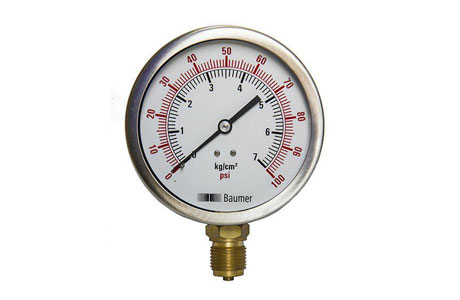What Are The Four Main Types Of Pressure Gauges?
Key Takeaway
The four main types of pressure gauges are Bourdon tube gauges, diaphragm gauges, digital gauges, and differential pressure gauges. Bourdon tube gauges are the most common, using a curved tube that straightens with pressure changes.
Diaphragm gauges use a flexible diaphragm to measure pressure, while digital gauges display readings electronically. Differential pressure gauges measure the difference between two pressures, often used in filtration or flow systems.
Bourdon Tube Pressure Gauges
Bourdon tube pressure gauges are widely used instruments known for their reliability and simplicity in measuring pressure. These gauges operate based on the deformation of a curved tube when exposed to pressure, translating mechanical movement into readable values on a dial. The design and construction of Bourdon tube gauges make them suitable for a range of applications, from industrial processes to HVAC systems.
Their durability and accuracy make them a popular choice for monitoring pressures in both gaseous and liquid systems. Understanding the function and benefits of Bourdon tube pressure gauges enables professionals to select the right tool for their specific needs, ensuring accurate and consistent pressure measurements.

Diaphragm Pressure Gauges
Diaphragm pressure gauges use a flexible diaphragm to measure pressure. When pressure is applied, the diaphragm deflects, and this deflection is converted into a readable measurement. The design of diaphragm gauges allows for accurate measurements in environments where the pressure is low to moderate.
This type of gauge is particularly suitable for applications where the fluid or gas being measured is viscous, corrosive, or contains particulate matter. Examples include the food and beverage industry, pharmaceutical applications, and chemical processing plants. Diaphragm gauges are typically used in environments where the fluid could potentially damage mechanical components or where pressure fluctuations need to be precisely monitored.
Advantages of diaphragm pressure gauges include:
Corrosion resistance: Ideal for use with aggressive or corrosive fluids.
Accurate for low to medium pressures: Well-suited for applications that require precision at lower pressure ranges.
Compact design: Space-efficient, making them suitable for tight spaces.
However, diaphragm gauges may not be the best choice for high-pressure or high-temperature environments due to their more limited range compared to Bourdon tube gauges.
You May Like to Read
Digital Pressure Gauges
Digital pressure gauges provide a modern solution for pressure measurement by using electronic sensors to detect changes in pressure. These gauges convert mechanical energy into electrical signals, which are then displayed on a digital screen. Digital gauges offer high precision and can be easily integrated into automated systems for remote monitoring and data logging.
Digital gauges are particularly useful in industries that require high accuracy, data recording, and remote monitoring. These include sectors like oil and gas, HVAC, medical, and automotive industries. Digital gauges often come with features like alarm systems, calibration capabilities, and data storage, making them ideal for environments where constant pressure monitoring is critical.
The advantages of digital pressure gauges are:
High precision: Provides highly accurate readings with minimal error.
Ease of use: The digital display is easy to read and interpret, reducing the risk of human error.
Advanced features: Many models include additional capabilities such as data logging and programmable alerts.
Despite their many advantages, digital gauges tend to be more expensive than mechanical options, and they may require periodic calibration and power sources to function effectively.
Differential Pressure Gauges
A differential pressure gauge measures the difference in pressure between two points within a system. It is widely used in applications where pressure variations between two locations are critical, such as in monitoring filters, pumps, and air flow systems. The differential pressure gauge is often found in HVAC systems, chemical plants, and industrial pipelines, where it is crucial to measure the pressure drop across components like filters or compressors.
By monitoring the pressure difference, differential gauges help ensure that systems are functioning efficiently and that no damage occurs due to excessive pressure differences. These gauges can also help identify issues such as blockages or filter failures before they lead to major system breakdowns.
Key benefits of differential pressure gauges include:
Efficiency monitoring: Helps detect early signs of system inefficiency or potential failure.
Wide application: Ideal for industries such as HVAC, pharmaceuticals, and chemical processing.
Real-time feedback: Provides continuous pressure readings to detect minor variations in system performance.
However, differential gauges are more complex than single-pressure gauges, requiring proper calibration and maintenance to ensure accurate readings.
Choosing the Right Type for Your Application
When selecting a pressure gauge, the application, the type of fluid or gas being measured, and the operating environment all play a critical role. For example, if you need to measure high-pressure systems in a manufacturing plant, a Bourdon tube gauge may be the most suitable choice due to its durability and high-pressure range.
If the system uses corrosive or viscous fluids, a diaphragm gauge might be more appropriate due to its ability to handle harsh environments. Digital gauges are ideal for applications requiring high precision, data logging, and remote monitoring, while differential pressure gauges excel at detecting pressure differences across systems.
It’s essential to consider factors like the pressure range, accuracy requirements, environmental conditions, and ease of use when choosing the most suitable pressure gauge for a particular application.
Conclusion
Pressure gauges are categorized into four main types: Bourdon tube, diaphragm, bellows, and digital gauges. Each type serves specific applications and functions based on its design and mechanism. Bourdon tube gauges, known for their mechanical operation, are widely used for general pressure measurement.
Diaphragm gauges are suitable for low-pressure applications, while bellows gauges excel in situations requiring more sensitivity. Digital gauges offer precise, electronic readings and are becoming increasingly popular due to their accuracy and ease of use. In conclusion, understanding the various types of pressure gauges allows users to select the most appropriate one for their specific needs.

